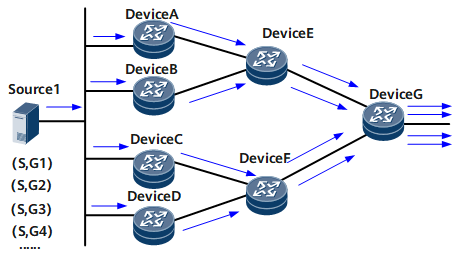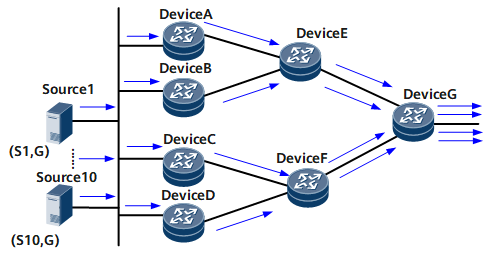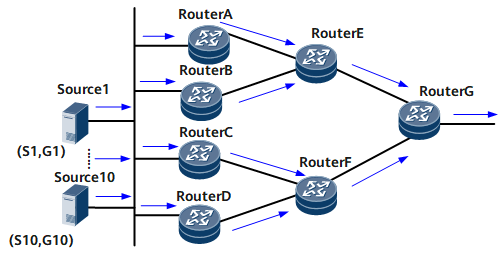Multicast Load Splitting
Multicast group-based load splitting
Multicast source-based load splitting
Multicast source- and group-based load splitting
Stable-preferred load splitting
Link bandwidth-based load splitting

Multicast group-based load splitting, multicast source-based load splitting, and multicast source- and multicast group-based load splitting are all methods of hash mode load splitting.
Multicast Group-based Load Splitting
The multicast group-based load splitting policy applies to the scenario in which a large number of multicast groups exist. Figure 1 shows the networking diagram of multicast group-based load splitting.
Based on the hash algorithm, a multicast router can select a route among several equal-cost routes for each multicast group. The routes are used for packet forwarding for the groups. As a result, multicast traffic for different groups can be split into different forwarding paths.
Multicast Source-based Load Splitting
Multicast source-based load splitting applies to the scenario in which a large number of multicast sources exist. Figure 2 shows the networking diagram of multicast source-based load splitting.
Based on the hash algorithm, a multicast router can select a route among several equal-cost routes for each multicast source. The routes are used for packet forwarding for the sources. As a result, multicast traffic from different sources can be split into different forwarding paths.
Multicast Source- and Group-based Load Splitting
Multicast source- and group-based load splitting applies to the scenario in which a large number of multicast sources and groups exist. Figure 3 shows the networking diagram of multicast source- and multicast group-based load splitting.
Based on the hash algorithm, a multicast router can select a route among several equal-cost routes for each source-specific multicast group. The routes are used for packet forwarding for the source-specific multicast groups. As a result, multicast traffic for different source-specific groups can be split into different forwarding paths.
Stable-preferred Load Splitting
A stable-preferred load splitting policy can be used in the preceding three load splitting scenarios, shown in Figure 1, Figure 2, and Figure 3.
Stable-preferred load splitting enables a router to select an optimal route for a new join entry. An optimal route is one on which the fewest entries depend. When the network topology and entries are stable, all entries with the sources on the same network segment are distributed evenly among the equal-cost routes.
If an unbalance occurs after entries are deleted or route costs change, stable-preferred load splitting does not allow a router to balance the existing entries immediately, but allows the router to select the optimal routes for subsequent entries to resolve the unbalance problem.
Stable-preferred load splitting is based on entries, not traffic. Therefore, if some multicast entries are not used to guide through traffic forwarding, multicast traffic may not evenly split among outbound interfaces, although the outbound interfaces have an equal number of multicast entries.
Link bandwidth-based Load Splitting
Link bandwidth-based load splitting applies to scenarios in which the links have different bandwidth.
On a multicast router capable of link bandwidth-based load splitting, when a new entry is generated, the router divides the interface bandwidth by the number of current interface entries for each equal-cost route. Then the router selects the route with the maximum calculation result as the forwarding route for this new entry.
If an entry is deleted, the router does not adjust the entry load. Therefore, the router cannot prevent unbalance of load splitting.


